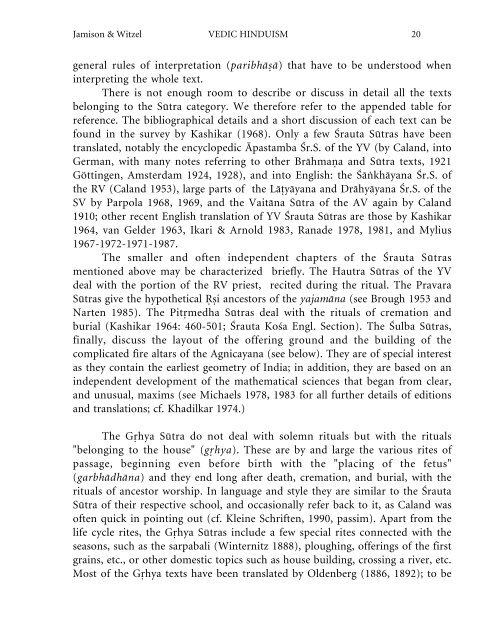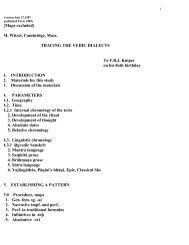VEDIC HINDUISM by S. W. Jamison and M. Witzel - people.fas ...
VEDIC HINDUISM by S. W. Jamison and M. Witzel - people.fas ...
VEDIC HINDUISM by S. W. Jamison and M. Witzel - people.fas ...
Create successful ePaper yourself
Turn your PDF publications into a flip-book with our unique Google optimized e-Paper software.
<strong>Jamison</strong> & <strong>Witzel</strong> <strong>VEDIC</strong> <strong>HINDUISM</strong> 20<br />
general rules of interpretation (paribhå�å) that have to be understood when<br />
interpreting the whole text.<br />
There is not enough room to describe or discuss in detail all the texts<br />
belonging to the Sūtra category. We therefore refer to the appended table for<br />
reference. The bibliographical details <strong>and</strong> a short discussion of each text can be<br />
found in the survey <strong>by</strong> Kashikar (1968). Only a few Śrauta Sūtras have been<br />
translated, notably the encyclopedic Āpastamba Śr.S. of the YV (<strong>by</strong> Cal<strong>and</strong>, into<br />
German, with many notes referring to other Bråhma�a <strong>and</strong> Sūtra texts, 1921<br />
Göttingen, Amsterdam 1924, 1928), <strong>and</strong> into English: the Śå�khåyana Śr.S. of<br />
the RV (Cal<strong>and</strong> 1953), large parts of the Lå�yåyana <strong>and</strong> Dråhyåyana Śr.S. of the<br />
SV <strong>by</strong> Parpola 1968, 1969, <strong>and</strong> the Vaitåna Sūtra of the AV again <strong>by</strong> Cal<strong>and</strong><br />
1910; other recent English translation of YV Śrauta Sūtras are those <strong>by</strong> Kashikar<br />
1964, van Gelder 1963, Ikari & Arnold 1983, Ranade 1978, 1981, <strong>and</strong> Mylius<br />
1967-1972-1971-1987.<br />
The smaller <strong>and</strong> often independent chapters of the Śrauta Sūtras<br />
mentioned above may be characterized briefly. The Hautra Sūtras of the YV<br />
deal with the portion of the RV priest, recited during the ritual. The Pravara<br />
Sūtras give the hypothetical ��i ancestors of the yajamåna (see Brough 1953 <strong>and</strong><br />
Narten 1985). The Pit�medha Sūtras deal with the rituals of cremation <strong>and</strong><br />
burial (Kashikar 1964: 460-501; Śrauta Kośa Engl. Section). The Śulba Sūtras,<br />
finally, discuss the layout of the offering ground <strong>and</strong> the building of the<br />
complicated fire altars of the Agnicayana (see below). They are of special interest<br />
as they contain the earliest geometry of India; in addition, they are based on an<br />
independent development of the mathematical sciences that began from clear,<br />
<strong>and</strong> unusual, maxims (see Michaels 1978, 1983 for all further details of editions<br />
<strong>and</strong> translations; cf. Khadilkar 1974.)<br />
The G�hya Sūtra do not deal with solemn rituals but with the rituals<br />
"belonging to the house" (g�hya). These are <strong>by</strong> <strong>and</strong> large the various rites of<br />
passage, beginning even before birth with the "placing of the fetus"<br />
(garbhådhåna) <strong>and</strong> they end long after death, cremation, <strong>and</strong> burial, with the<br />
rituals of ancestor worship. In language <strong>and</strong> style they are similar to the Śrauta<br />
Sūtra of their respective school, <strong>and</strong> occasionally refer back to it, as Cal<strong>and</strong> was<br />
often quick in pointing out (cf. Kleine Schriften, 1990, passim). Apart from the<br />
life cycle rites, the G�hya Sūtras include a few special rites connected with the<br />
seasons, such as the sarpabali (Winternitz 1888), ploughing, offerings of the first<br />
grains, etc., or other domestic topics such as house building, crossing a river, etc.<br />
Most of the G�hya texts have been translated <strong>by</strong> Oldenberg (1886, 1892); to be

















